Gensac, Gironde, Nouvelle-Aquitaine 作者: 来源: 发布时间:2021-09-23
I.Population and Area
Total Area: 9.38 km2
Population in 2017: 771
Population Density: 82 /km2
Histogram of demographic change
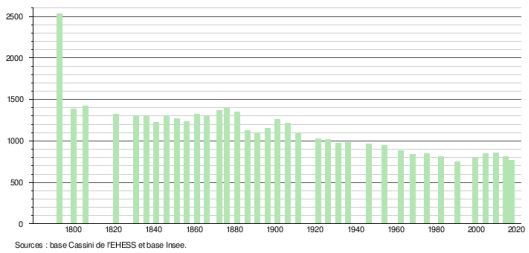
II.Natural Geography (environment and resources)
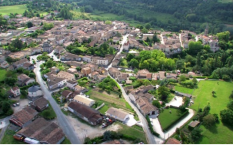
Gensac is a town in southwestern France, located in the Gironde department (Nouvelle-Aquitaine region).
Gensac is a village located in Gironde, on the slopes of the Dordogne (river), halfway between Castillon-la-Bataille and Sainte-Foy-la-Grande, that is to say on the eastern edge of the vineyard from Entre Deux Mers (wine region in the south of Bordeaux) and the Sainte-Foy Bordeaux appellation. The town is bordered by two rivers: the Durèze to the west, the Soulège to the east.
III.ECONOMY
Employment rate (%): 74.3 (2017)
Average employment income (€):1 647 net per month (19 764 net per year)(2018)
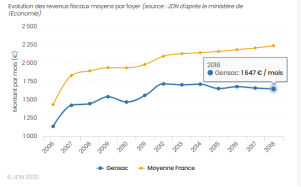
Evolution of average monthly net wages
Sources : http://www.journaldunet.com/business/salaire/gensac/ville-33186
https://insee.fr/fr/statistiques/2011101?geo=COM-33186
IV.Industrial Characterisitics
Sectors of activity most represented in Gensac
The table below lists the five sectors of activity with the most companies in Gensac during the period from 24/09/2019 to 24/09/2020 as well as the share of each sector on the total number of 'enterprises of the municipality.
Sector of activity | Number of companies | Share of companies |
Rental and operation of own or leased real estate | 44 | 24.2% |
Permanent crops | 34 | 18.7% |
Activities of other membership organizations | 9 | 4.9% |
Creative, artistic and performing activities | 7 | 3.8% |
Retail, trade not in stores stalls or markets | 6 | 3.3% |
Sources: http://entreprises.lefigaro.fr/gensac/ville-33186
V.Attractions
1.Notre-Dame Church
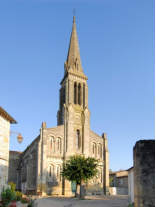
IDENTIFICATION
Parish church
Name: Municipality of Gensac
Address: Hôtel de Ville 1 place de l'Hotel de Ville
Fax: 05 57 47 46 63
Website: gensac.free.fr
Assignee
Name: Notre-Dame Parish
Community of communes
Name: Community of municipalities Castillon - Pujols
ARCHITECTURE AND ART
Period and styles
XIXth
Main stages of construction
The building was restored in the 19th century.
RELIGIOUS AND CULTURAL LIFE
Assignment / Usage
Worship.
2.Gensac old village
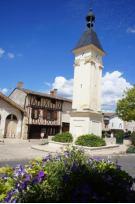
The village of Gensac, built on a promontory overlooking the Dordogne valley has kept several witnesses of its medieval past. Of the castle, all that remains is a section of wall and the remains of a postern. The Romanesque church of Notre-Dame, rebuilt in the 19th century, dominates the village with its picturesque streets with its bell tower, where there are beautiful houses from the 14th and 15th centuries, some of which are half-timbered. The cat house where the knight was killed de Pardaillan, and a few half-timbered houses deserve special attention, as does the dead-end pulpit known as
"Calvin's Chair" at the corner of the Town Hall courtyard. Under the castle there is a very deep cave where superstition lodges the Chausse Bielhe, a fantastic being, which at night crouches on sleepers' chests and prevents them from breathing.
Sources: https://www.patrimoine-religieux.fr/eglises_edifices/33-Gironde/33186-Gensac/122851-EgliseNotre-Dame
https://www.gironde-tourisme.fr/patrimoine-culturel/village-ancien-de-gensac/
VI.History
Prehistory
There is no trace of prehistoric habitat in the town of Gensac. The climate and geography were different today and the Gensac plateau did not lend itself to long-term habitat. The historical archives of the Gironde department speak of amber beads found in the 19th century near the Roc eel tumulus. Item, locals talk about Neolithic tools discovered during the expansion of the wine cellar. But no real implantation. These are undoubtedly temporary hunting camps, coming from the banks of the Dordogne for a hunting party on the Gensac plateau. The Neolithic men being pragmatic, their establishments were rather located near the river ...
antiquity
In Celtic then Gallo-Roman Antiquity, the Gensac site leaves no trace. No doubt a few farms are on the plateau, but most of the economic activity is found in the Dordogne valley, with the Gallo-Roman villa of Montcaret and those near Castillon-la-Bataille and Saint- Emilion. Traces of a villa were discovered during the restoration of the church of Pessac sur Dordogne, formerly Pessac de Gensac.
Middle Ages
It was in the Middle Ages that Gensac really developed. Eleanor having brought Aquitaine into the English fold, the Dordogne valley is gradually strengthened. In 1340, Mathe d'Albret ceded to the Seneschal of Gascony Olivier de Joglan (acting on behalf of the King of England) the castles and squares of Bragerac, with all the places and squares that once flourished to the Lord of Bragerac, in the diocese. of Toulouse, also the town of Montignac with its affiliations, Gensac, Monhurt and other places, on condition that the said lady would receive the fruits of the places and places ... (Departmental Archives of the Gironde, coast C7 (368 - LIII)). Most of the fortified castles and fortified houses date from this period.
The old medieval Gensac is built on a rock in the shape of the bow of a boat. You have to stretch your imagination because there is hardly anything left of it; only a piece of wall, near the Notre-Dame church, recalls the stronghold of yesteryear, which watched over the Dordogne valley and the Durèze valley (small local river). The city of Gensac will be English until the battle of Castillon in 1453 and the end of the Hundred Years War. In 1473, King Louis XI gave (by letters patent) to Sire d'Albret the land of Saincte Bazeille, Gensac and Montcuq, Langoyran, Blasimont and Pellegrue (Departmental Archives, coast X11 (368 - CIII)).
The citadel is very small. On the promontory, a castle is built with two towers and a freestone wall which surrounds what today corresponds to the old village. A ditch is dug in the rock and one enters the citadel by a drawbridge flanked by two towers. A garrison is maintained by the seneschals of Castelmoron d'Albret with foot sergeants and riders (the old stables were dug into the rock and today form a large vaulted room in a private home). A wooden church is built on the rampart; it will burn several times (pure elucubration!) (the current stone church dates from the 19th century which replaced a stone church, threatening ruin in the 19th century). The legend (but this is only a legend) speaks of undergrounds. Admittedly there are caves dug in the rock, but no research has made it possible to find underground passages hollowed out beyond a few meters. The rest of the village is outside the walls; these are farms grouped into hamlets. In Pessac de Gensac (now Pessac-sur-Dordogne), a ford in summer and a ferry in winter allow you to cross the Dordogne at the location of the current bridge.
On the slopes, a series of castles or fortified houses, dating from the fourteenth century, watch over the French enemy: tower of Bellevue, Montbreton, tower of Beaupoil. An underground has been found between Montbreton and Bellevue. It seems that the Bellevue tower was an advanced defense of the castle of Montbreton and that this underground, a series of caves arranged in rows, served as reserves and passage for troops on foot. Still in the fourteenth century, in Pessac, on the banks of the Dordogne, the manor of Bernède was built to serve as a toll booth and protection for the English troops. Similarly, in the 15th century, the castle of Vidasse was built to protect the ferry and the ford.
Reform
During the seventeenth and then the eighteenth century, the Protestant Reformation attracted many noble Gascon. Most of the population follows their lord. Protestantism is growing. In the jurisdictions of Gensac and Sainte-Foy la Grande, a significant Protestant community is developing. The construction of temples is widespread. Calvin would have come to preach in Gensac, but what is presented as the chair of Calvin did not yet exist.
The religious wars in Gensac
1559: construction of the Gensac temple.
1560: helping hand between Protestants and Catholics.
1575: first siege of Gensac led by Blaise de Montluc, the suburb falls into the hands of the Catholic army; the city is not taken, but surrendered.
1622: second siege of Gensac, during the assault, Montferrand is killed; the besiegers withdraw without having been able to take the city but they set fire to the suburb which is destroyed; during the same period, fighting between Gensac and Pessac, 200 reformed were killed.
1685: destruction of the Gensac temple.
Sources: 15th conference (CLEM) & SHPVD.
From Henri IV to Louis XVI
Returned to the rule of the kings of France, Gensac remained a military town until the Revolution. The kings maintain a garrison in the castle. The Lord of Gensac resides in the castle of Montbreton (currently in the town of Pessac-sur-Dordogne). When a messenger arrives or an important event occurs, pennants and flags are hoisted on the tower near Notre-Dame church. We see them from Montbreton and the lord of Gensac decides whether or not to move.
A company of Gascon riders permanently resides in the citadel. The archives of the Parliament of Bordeaux relate that, under Louis XIII, Cadillac cadets took a trip to Bordeaux to go see the gangs of bad neighborhoods. They did not go further than the Bastide toll (one of the entrances to the city of Bordeaux). Having already drunk well on the way, they refused to pay the right of way and massacred two or three guards. A chase ensued which, in one night, made them cover more than 45 kilometers, and saw them take refuge in Gensac. They were outside the jurisdiction of the Parliament of Bordeaux. Despite all the latter's requests, the Duke of Épernon (on whom the place of Gensac depended) refused to hand them over to the Bordeaux courts. We have no record of the Duke's decision against them. But as his relations with the Parliament of Bordeaux were quite strained at that time, there is no doubt that he was lenient.
The water and windmills as well as the boat-mills on the Dordogne (moulinasses) experienced great development from the sixteenth to the eighteenth century. This is proof that the country is prospering and agriculture is developing. We cut down forests, we advance animal husbandry and grain production. The towns of Castillon and Sainte-Foy are growing and no longer have the capacity to be self-sufficient in food. The surrounding countryside becomes productive. The Dordogne serves as a trade route with the barges. Cassini's map (completed under Louis XV) shows 15 watermills and more than 30 windmills in the people of the countryside. A few boat mills on the Dordogne complete the range. Such a profusion for a small village shows its economic dynamics at this time.
During the reign of Louis XV, the citadel and the castle began to be dismantled. During the French Revolution, the castle completely disappeared. As the major conflicts are no longer in the southwest, it becomes unnecessary to keep a garrison (even a small one) in Gensac. The stones from the ramparts and the castle will be used to build the new houses of the village which grows beyond the ditches: town hall, the Allées, the Grand-Rue district, but also a number of surrounding farms where the there are fireplaces, windows, rooms recovered from the castle.
Modern times
In 1789, the Gensacais participated in the development of a book of grievances which was collected in Libourne on March 11 for the entire Senechaussee. A national guard was created in 1790: harsh winter, food shortage, famine in 1789 prompted the inhabitants to form a body of national guards to ensure the free movement of wheat and basic food. This local guard will not prevent the diversion of food and a famine in the following years.
In September 1793, the general council of Gensac, appreciably distressed by the state of distress in which the citizens of Bordeaux found themselves, with regard to subsistence and wanting to give them unequivocal proof of its attachment and recognition, offered a large quantity of grain. which will be transported by boat to Bordeaux. (Max Bonaval; History of the commune of Gensac pp 16 and 17).
Until the Directory (October 1795), the population suffered from food shortages and local elected officials had difficulty meeting their needs.
At the beginning of the Empire, the mayors resulting from the Revolution were resigned en masse. New Mayors are elected, more favorable to the emperor. Gensac does not cut it and it is Pierre Martel senior who is elected. On August 3, 1807, an important event occurs with the partition of the town: Pessac-de-Gensac (former parish, annex of Gensac) becomes a full town under the new name of Pessac-sur-Dordogne.
From the First Empire to the Second Empire, via the Restoration, the Gensacais followed suit and were in turn for the emperor, then royalists and then for the new emperor.
The Notre-Dame church was rebuilt in stone between 1867 and 1878.
All the information in this chapter is taken from: Histoire de la Commune de Gensac, Max Bonaval, self-published in 1986 [insufficient source]
XXth century
The minutes of the Archaeological Society of Bordeaux of 1905 (Archaeological Society of Bordeaux, volume 27) relate the discovery of a treasure by the sieur Alphonse Faux, road mender in Gensac. In 1904, excavating the floor of the old stables, A. Faux discovered 555 double copper tournaments. Cleaned, the pieces still in good condition show dates ranging from 1619 to 1643. Louis XIII having died in 1643, it would therefore be during the last year of his reign, or at the very beginning of the reign of Louis XIV that this treasure would have been hidden underground.
The First World War took 43 children from the people of the people of Provence.
During the Second World War, the demarcation line passed a little north of Gensac. The village was in the free zone until November 1942.
VII.Other information
Civil heritage
The old village, renovated since the 1990s. Place de la Halle; stone rings for tying pack animals.
The clock tower, the village belfry.
The Maison aux Chats dating from the 14th century.
The house with watchtower, 17th century.
Calvin's Town Hall and Chair.
Several water or windmills.
The “Old Baker's House” houses a folk art museum which traces the life of the people of the city from 1850 to 1950.
The half-timbered house, the only one in the village, facing the clock, dating from the sixteenth century.

VIII.Contact information
Gensac town hall address :
Gensac town hall
1 Place de l'Hotel-de-Ville
33890 Gensac
Mayor : Patrice Pauletto (Mandate : 2014-2020)
Mail: secretariat.gensac@wanadoo.fr
Phone number: 05 57 47 42 37
Fax: 05 57 47 46 63
Website : http://gensac.fr
Sources : http://www.cartesfrance.fr/carte-france-ville/33186_Gensac.html
